Steel Products Prices North America

Raw Materials Prices: Iron Ore, Coking Coal, Pig Iron, Scrap, Zinc
Written by Brett Linton
October 21, 2021
Prices for four of the seven steelmaking raw materials tracked in this SMU analysis increased over the last 30 days. Through Oct. 20, zinc prices shot up 24% over one month prior, iron ore prices rebounded 18% in one month’s time, aluminum prices rose 9%, and coking coal prices increased 8%. In that same time frame, scrap prices declined 2-3% and pig iron prices fell 2%.
Table 1 summarizes the price changes of the seven materials considered in this analysis. It reports the percentage change from one month prior, three months prior, and one year prior for each material.
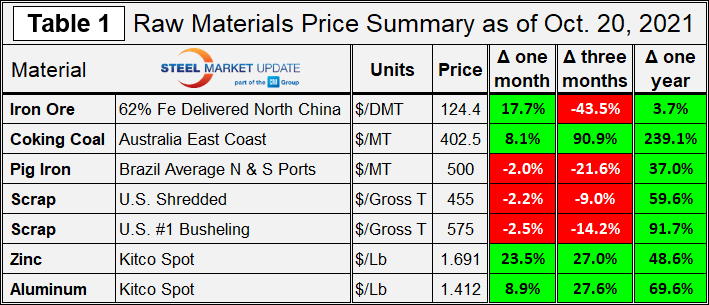
Iron Ore
The Chinese import price of 62% Fe content iron ore fines had been soaring upward for over a year, but began to slip in July/August. Prices fell through late-September and have bounced upwards since. Figure 1 shows the price of 62% Fe delivered North China at $124.4/dmt as of Oct. 20. Iron ore prices have rebounded 17% in the last 30 days, down 44% compared to three months ago and up 4% over the price this time last year.
A CRU report from Oct. 19 notes iron ore prices are stabilizing at just over $120/dmt. CRU Principal Analyst Erik Hedborg reported: “Iron ore prices have fallen in the past week and are now trading just above $120 /dmt. Steel production in China has been increasing recently, but rising iron ore inventories are limiting the upside potential for prices.”
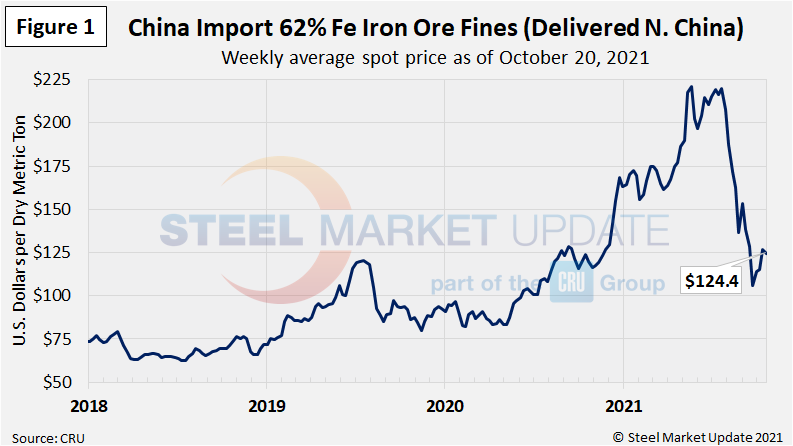
Coking Coal
The price of premium low volatile coking coal FOB east coast of Australia has continued to surge since May, reaching $402.5 per dry metric ton as of Oct. 20 (Figure 2). Prices are up 8% in the last 30 days, up 91% in the past three months, and up a whopping 239% over levels one year prior. The last time coking coal prices were this high was over 13 years ago, going back to July 2008.
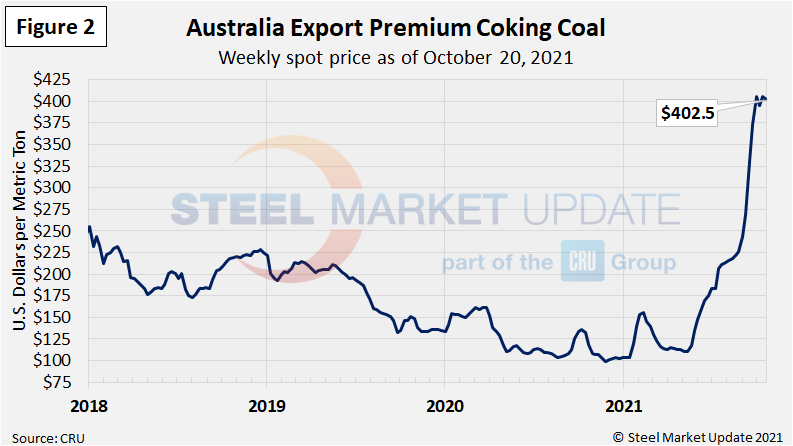
Pig Iron
Most of the pig iron imported to the U.S. currently comes from Russia, Ukraine and Brazil. This report summarizes prices out of Brazil and averages the FOB value from the north and south ports. The latest data shows pig iron prices have declined 22% from the June/July peak, now averaging $500 per metric ton in October. Although down over the summer months, pig iron prices have remained historically high for the past 10 months and are up 37% from levels one year ago. Recall that pig iron prices had reached a multi-year low of $275 per metric ton in May 2020, with prices increasing each month thereafter through January 2021 (Figure 3).
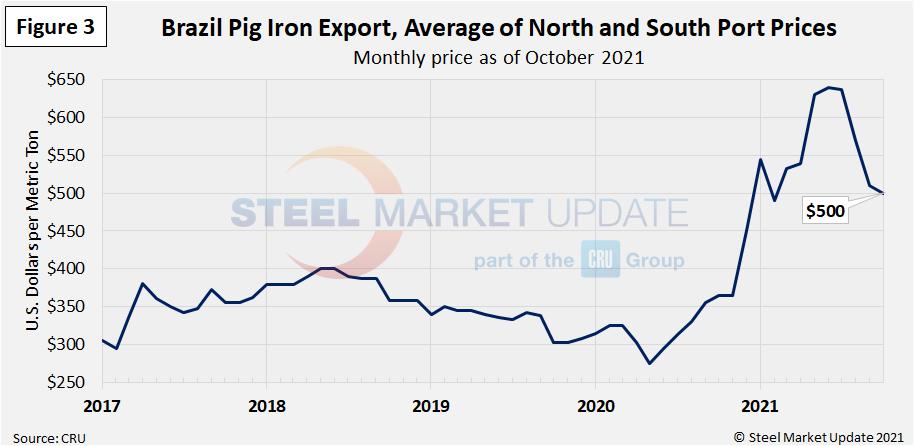
Scrap
Hot rolled steel prices fluctuate up and down with the price the mills must pay for their raw materials. Changes in the relationship between scrap and iron ore prices offer insights into the competitiveness of integrated mills, whose primary feedstock is iron ore, versus the minimills, whose primary feedstock is scrap. Figure 4 shows the spread between shredded and busheling scrap, priced in dollars per gross ton in the Great Lakes region. October scrap prices declined 2-3% from September yet remain high historically, up 60-92% compared to prices one year ago. Prior to 2021, the previous record for scrap prices over the last decade was $510 per ton for busheling in December 2011, and $473 per ton for shredded in February 2012.
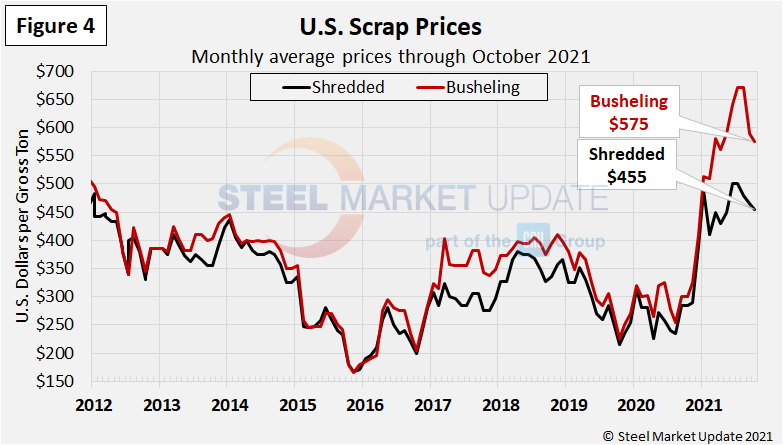
Figure 5 shows the prices of mill raw materials over the past four years. The price of iron ore has declined 44% from the mid-May 2020 peak of $221 per dry metric ton. Shredded scrap eased 2% from September to October, down 9% from the June/July peak.
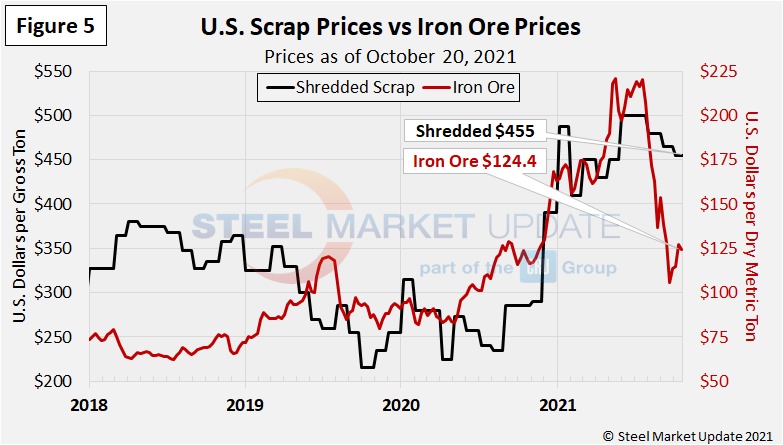
To compare the two, Steel Market Update divides the shredded scrap price by the iron ore price to calculate a ratio (Figure 6). A high ratio favors the integrated/BF producers, a lower ratio favors the minimill/EAF producers. At the current 3.66 ratio shown below, the cost advantage formerly held by minimills is lessening, having surpassed the black four-year average ratio line back in late-August. The ratio reached a 33-month high of 4.40 in late-September, declining each of the following three weeks. The scrap to iron ore ratio reached a record-low of 1.86 in August 2020 (within SMU’s 12-year limited data history).
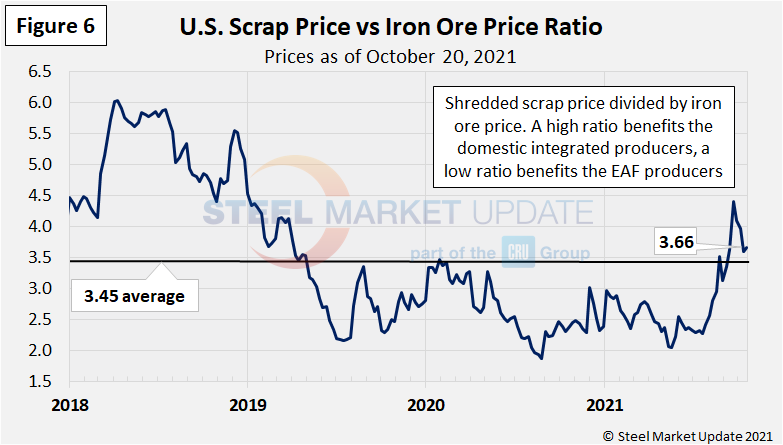
Figure 7 shows how the price of hot rolled steel generally tracks with the price of busheling scrap. Bush was down $15 or 3% from September to October, up $63 from the beginning of the year, and up $275 from one year ago. The SMU hot rolled price average declined last week for the second consecutive week, with the latest average down $10 to $1,910 per ton as of Oct. 19; this is down $35 per ton from the prior month, up $900 per ton since the start of the year, and up $1,235 per ton over one year ago.
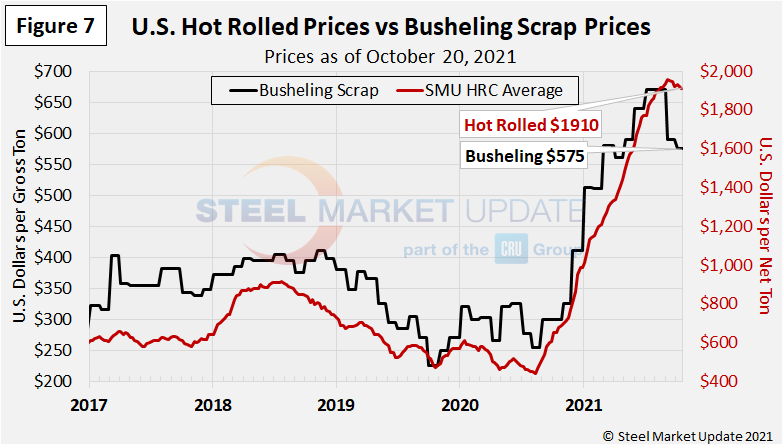
Zinc and Aluminum
Zinc, used to make galvanized and other products, has been on the rise since March 2020 and reached a multi-year high of $1.7369 per pound on Oct. 15 (Figure 8). The LME cash price for zinc as of Oct. 20 is $1.6911 per pound, up 27% from three months prior, and up 49% from the same time last year. The price of zinc factors into the coating extras charged by the mills for galvanized products.
Aluminum prices, which factor into the price of Galvalume, have been trending upwards since May 2020. Aluminum prices also reached a record-high of $1.4399 per pound on Oct. 15, the highest daily price seen in our 10-year history (note that aluminum prices often have large swings and return to typical levels within a few days, as seen in the graphic below; we do not consider those surges in our overall high/low comparisons). The latest LME cash price of aluminum is $1.4118 per pound as of Oct. 20, up 28% over three months ago and up 70% from one year prior.
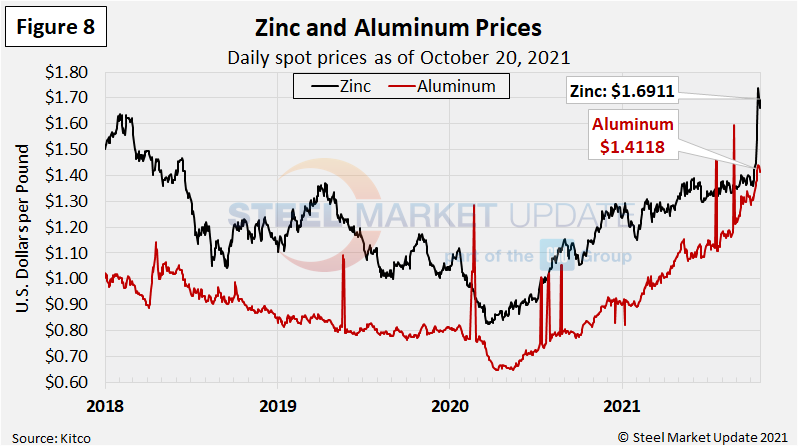
By Brett Linton, Brett@SteelMarketUpdate.com

Brett Linton
Read more from Brett LintonLatest in Steel Products Prices North America

BREAKING NEWS: Nucor surprises with $65/ton price drop for HRC
Nucor started off May with a bang, dropping its weekly base spot price for hot-rolled (HR) coil by $65 per short ton (st) this week.

Nucor drops weekly HR coil price by $10/ton
Nucor lowered its weekly base spot price for hot-rolled (HR) coil by $10 per short ton (st) this week.

Nucor holds HR price steady this week
Nucor is holding its hot-rolled (HR) coil consumer spot price (CSP) flat this week.

SMU price ranges: Sheet, plate largely unchanged
Sheet prices varied this week. While hot-rolled (HR) coil pricing was largely flat, cold-rolled (CR) coil and tandem product pricing eased slightly reflecting the momentum shift seen last week for HR coil. SMU’s average HR coil price was flat from last week at $835 per short ton (st) – potentially emphasizing the tension between competing […]

Nucor posts $830/ton spot HR price for week of April 8
Nucor said its spot hot-rolled (HR) coil price this week will be $830 per short ton (st).
